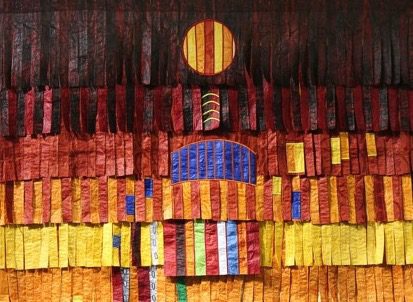FM Centro per l’Arte Contemporanea, Milan, Italy
31 Mar 2017 - 03 Jun 2017

Abdoulaye Konaté, Homme du Sahel, 2015 (detail), Textile, Cm 218 x 145, Courtesy Primo Marella Gallery, Milano
FM Centro per l’Arte Contemporanea present the third event of its exhibition program during the Milan Art Week and on the occasion of the next edition of miart – International Modern and Contemporary Art Fair: Il Cacciatore Bianco/The White Hunter. Memorie e rappresentazioni africane.
The new and wide ranging collection curated by Marco Scotini – following on from the success of the preceding The Unarchivable dedicated to the 1970s in Italy and Non-Aligned Modernity regarding the Yugoslavian artistic scene during the Cold War – presents an investigation into the decentralization of the hegemonic and indisputable model of western artistic modernity in the current geo-political scenario.
With over 40 artists and more than 120 works, Il Cacciatore Bianco/The White Hunter presents a path articulated around the forms of representation and reconstruction of memory and of African contemporary reality through works from major Italian collections and archive material concerning the contexts of both Italian and international critical and exhibition presentation.
The exhibition title refers to the film works of the artists Yervant Gianikian and Angela Ricci Lucchi, pioneers in the practice of rewriting colonial and migration history, and follows the social construction of a presumed supremacy of the “blanchité” that ran through the whole experience of capitalist modernism and was consolidated by the colonial enterprise, interwoven with a particularly Italian situation.
The contemporary art works are placed in dialogue with a nucleus of traditional, antique works of art, in which collection and exhibition practices are also the subject of research. The sections of traditional, antique art works take their inspiration from and ideally connect back to the first presentation of African art objects at the Venice Biennale in 1922, at the dawn of Fascism. They include a nucleus of statues and masks from Mali, the Ivory Coast, Cameroon, Gabon, the Congo and Angola and aim to ‘evoke ‘both the aforementioned historic moment as well as its aesthetic sensitivity. The subsequent exclusion of African art from official events and from the Italian cultural debate stands as the background to an investigation into its presence in private Italian collections, more open to international stimuli. By means of archive and documentary material, objects and historic maps, the experiences of academics and documentarists who have provided a significant contribution to the very definition of African art, its historiography and the development of its collection, overcoming the anthropological split between works of art and ethnographic documents, are revived.
Some significant works by contemporary African artists have emerged from the Italian collections and highlight the problems inherent in the very notion of African identity: like the wigs by Meschac Gaba whose interwoven African hairstyles take the form of Milanese architecture, or the banners by the same artist that stood over an imaginary Museum of Contemporary African Art with a nomadic presence in various European cities. Or Georges Adéagbo’s installations-archives in which he assembles evidence, images and publications that testify to the political and social questions and the stereotypes representing African otherness. There is also Kader Attia’s investigation into the forms of post-colonial, cultural re-appropriation, displayed in a series of videos in which he explores the concept of ‘reparation’ between the West and ‘other’ cultures. Or there are the great woven works by Abdoulaye Konaté that revive the cultural traditions of Mali, exploring socio-political questions around globalization, religious fanaticism and ecology. Also, the paintings by Wangechi Mutu and Ouattara Watts are included as well as Seydou Keïta’s photographic works, and the South African question is addressed in the works by William Kentridge and David Goldblatt. These are works that testify to the richness of artistic research expressed as the practice of reappropriation and resistance to the various forms of exclusion, hegemony and certification, in line with a discourse of affirmation in the contemporary debate generated by the emergence of large, international exhibitions dedicated to the African continent, its diasporas, independence and the battles for cultural and political de-colonialization.
The project, curated by Marco Scotini, has benefitted from a committee of multi-disciplinary advisors which includes: Gigi Pezzoli, Africanist, Grazia Quaroni, senior curator, the Fondation Cartier pour l’art contemporain, Adama Sanneh, program director, Fondazione lettera27, and others.
The exhibition is accompanied by a program of seminars, conferences and screenings arranged in collaboration with Fondazione lettera27, Biennale di Lubumbashi, and other organizations.
Artists : Georges Adéagbo, El Anatsui, Kader Attia, Sammy Baloji, Fréderic Brouly Bouabré, Edson Chagas, Nidhal Chamekh, Meschac Gaba, Pascale Marthine Tayou, Abdoulaye Konaté, Ellen Gallagher, Kendell Geers, Yervant Gianikian and Angela Ricci Lucchi, David Goldblatt, Bodys Isek Kingelez, William Kentdrige, Ibrahim Mahama, Fabio Mauri, Wangechi Mutu, Yinka Shonibare, Malick Sidibé, Kara Walker, Ouattara Watts, Lynette Yiadom-Bouakye, Cyprien Tokoudagba and others.
Collections: AGI Verona Collection, Collezione Berna, Collezione Bifulco, Collezione Carini, Collezione Carmignani, Collezione Giuseppe Iannaccone, Collezione Christoph Jenny, Fondazione Ligabue, Collezione Emilio e Luisa Marinoni, Nomas Foundation, Collezione E. Righi, Fondazione Sandretto Re Rebaudengo, Collezione Gemma Testa, Collezione Vigorelli and others.
.
OPENING: 30th March, 8pm
.